D-double-flat melodic minor scale
The Solution below shows the Dbb melodic minor scale notes, intervals and scale degrees on the piano, treble clef and bass clef.
The Lesson steps then describe how to identify the D-double-flat melodic minor scale note interval positions, choose the note names and scale degree names.
For a quick summary of this topic, have a look at Melodic minor scale.
| Key | C | C# | Db | D | D# | Eb | E | E# | Fb | F | F# | Gb | G | G# | Ab | A | A# | Bb | B | B# | Cb | All On 1 page |
|---|
Solution - 3 parts
1. D-double-flat melodic minor scale
The D-double-flat melodic minor scale has 6 double-flats, 1 flat.
Warning: The D-double-flat key is a theoretical melodic minor scale key.
This means:
> Its key signature would contain either double-sharps or double flats.
> It is rarely used in practice, because it is too complex to use.
> It is not shown as a minor key on the Circle of fifths diagram, which contains the most commonly used minor keys.
> There is always an identical melodic minor scale that you can use in its place, which is on the Circle of 5ths.
> The C melodic minor scale sounds the same / contains the same note pitches, which are played in the same order, and so it can be used as a direct replacement for the D-double-flat melodic minor scale.
| Note no. | Note interval | Note name |
|---|---|---|
| 1 | tonic | The 1st note of the D-double-flat melodic minor scale is Dbb |
| 2 | Dbb-maj-2nd | The 2nd note of the D-double-flat melodic minor scale is Ebb |
| 3 | Dbb-min-3rd | The 3rd note of the D-double-flat melodic minor scale is Fbb |
| 4 | Dbb-perf-4th | The 4th note of the D-double-flat melodic minor scale is Gbb |
| 5 | Dbb-perf-5th | The 5th note of the D-double-flat melodic minor scale is Abb |
| 6 | Dbb-maj-6th | The 6th note of the D-double-flat melodic minor scale is Bbb |
| 7 | Dbb-maj-7th | The 7th note of the D-double-flat melodic minor scale is Cb |
| 8 | Dbb-perf-8th | The 8th note of the D-double-flat melodic minor scale is Dbb |
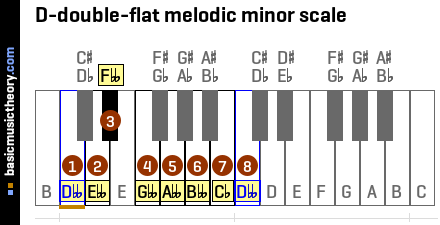
Middle C (midi note 60) is shown with an orange line under the 2nd note on the piano diagram.
These note names are shown below on the treble clef followed by the bass clef.
On the bass clef, Middle C is shown with an orange ledger line above the main 5 staff lines.


The stave diagrams above show the scale notes without a key signature, with the sharp / flat adjustments inserted before each note on the staff.
For the key signature of this scale, showing the symbols grouped correctly next to the bass or treble clef symbol at the beginning, have a look at the Dbb melodic minor key signature.
| Note no. | Degree name |
|---|---|
| 1 | Dbb is the tonic of the D-double-flat melodic minor scale |
| 2 | Ebb is the supertonic of the D-double-flat melodic minor scale |
| 3 | Fbb is the mediant of the D-double-flat melodic minor scale |
| 4 | Gbb is the subdominant of the D-double-flat melodic minor scale |
| 5 | Abb is the dominant of the D-double-flat melodic minor scale |
| 6 | Bbb is the submediant of the D-double-flat melodic minor scale |
| 7 | Cb is the leading tone of the D-double-flat melodic minor scale |
| 8 | Dbb is the octave of the D-double-flat melodic minor scale |
For ascending scale notes, the difference between the D-double-flat melodic minor scale and the Dbb natural minor scale is that the 6th and 7th note positions of the minor scale are raised by one half-tone / semitone.
So whereas the Dbb natural minor scale has notes Bbbb, Cbb for the 6th and 7th notes, these notes are raised to arrive at notes Bbb, Cb for this melodic minor scale.
| Bass Clef: | Midi | MP3 | Treble Clef: | Midi | MP3 |
2. D-double-flat melodic minor scale reverse descending
The difference between the two types of melodic minor descending variations are explained in steps 6 and 7 of the Lesson steps below.
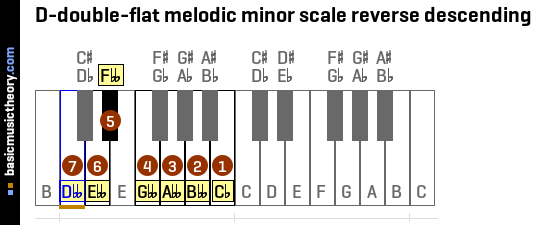


| No. | 1 | 2 | 3 | 4 | 5 | 6 | 7 |
|---|---|---|---|---|---|---|---|
| Note | Cb | Bbb | Abb | Gbb | Fbb | Ebb | Dbb |
| Bass Clef: | Midi | MP3 | Treble Clef: | Midi | MP3 |
3. D-double-flat melodic minor scale classical descending
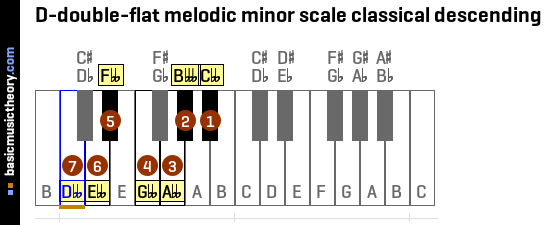


| No. | 1 | 2 | 3 | 4 | 5 | 6 | 7 |
|---|---|---|---|---|---|---|---|
| Note | Cbb | Bbbb | Abb | Gbb | Fbb | Ebb | Dbb |
| Bass Clef: | Midi | MP3 | Treble Clef: | Midi | MP3 |
Lesson steps
1. Piano key note names
The white keys are named using the alphabetic letters A, B, C, D, E, F, and G, which is a pattern that repeats up the piano keyboard.
Every white or black key could have a flat(b) or sharp(#) accidental name, depending on how that note is used. In a later step, if sharp or flat notes are used, the exact accidental names will be chosen.
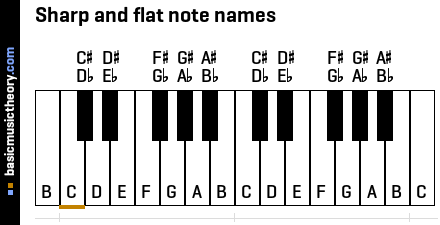
The audio files below play every note shown on the piano above, so middle C (marked with an orange line at the bottom) is the 2nd note heard.
| Bass Clef: | Midi | MP3 | Treble Clef: | Midi | MP3 |
2. D-double-flat tonic note and one octave of notes
The numbered notes are those that might be used when building this note scale.
But since this is a scale in the key of Dbb, it is certain that notes 1 and 13 will be used in the scale.
Note 1 is the tonic note - the starting note - Dbb, and note 13 is the same note name but one octave higher.
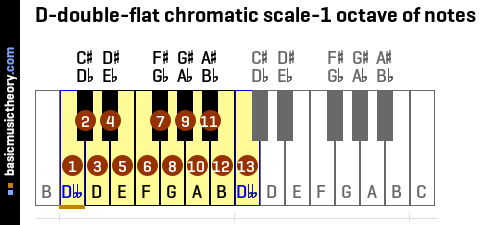
| No. | 1 | 2 | 3 | 4 | 5 | 6 | 7 | 8 | 9 | 10 | 11 | 12 | 13 |
|---|---|---|---|---|---|---|---|---|---|---|---|---|---|
| Note | Dbb | C# / Db | D | D# / Eb | E | F | F# / Gb | G | G# / Ab | A | A# / Bb | B | Dbb |
| Bass Clef: | Midi | MP3 | Treble Clef: | Midi | MP3 |
3. D-double-flat melodic minor scale note positions
The melodic minor scale uses the W-H-W-W-W-W-H note counting rule to identify the scale note positions.
To count up a Whole tone, count up by two physical piano keys, either white or black.
To count up a Half-tone (semitone), count up from the last note up by one physical piano key, either white or black.
The tonic note (shown as *) is the starting point and is always the 1st note in the melodic minor scale.
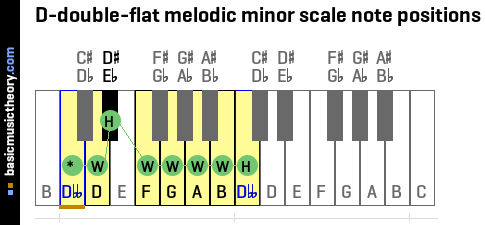
| No. | 1 | 2 | 3 | 4 | 5 | 6 | 7 | 8 |
|---|---|---|---|---|---|---|---|---|
| Note | Dbb | D | D# / Eb | F | G | A | B | Dbb |
What is the difference between the D-double-flat melodic minor scale and the Dbb natural minor scale ?
The 6th and 7th note positions (or scale degrees) of the minor scale are raised by one half-tone / semitone to arrive at the melodic minor scale note positions shown above.
| Bass Clef: | Midi | MP3 | Treble Clef: | Midi | MP3 |
4. D-double-flat melodic minor scale notes
The 7 unique notes in a scale need to be named such that each letter from A to G is used once only, so each note name is either a natural white name(A.. G) , a sharp(eg. F#) or a flat(eg. Gb).
The rule ensures that every position of a staff is used once and once only - whether that position be a note in a space, or a note on a line.
This is needed to ensure that when it comes to writing the scale notes on a musical staff (eg. a treble clef), there is no possibility of having 2 G-type notes, for example, with one of the notes needing an accidental next to it on the staff (a sharp, flat or natural symbol).
To apply this rule, firstly list the white key names starting from the tonic, which are shown the White column below.
Then list the 7 notes in the scale so far, shown in the next column.
For each of the 7 notes, look across and try to find the White note name in the Scale note name.
If the natural white note can be found in the scale note, the scale note is written in the Match? column.
The 8th note - the octave note, will have the same name as the first note, the tonic note.
| No. | White | Scale note | Match? |
|---|---|---|---|
| 1 | D | Dbb | Dbb |
| 2 | E | D | m |
| 3 | F | D# / Eb | m |
| 4 | G | F | m |
| 5 | A | G | m |
| 6 | B | A | m |
| 7 | C | B | m |
| 8 | D | Dbb | Dbb |
For this scale, there are 6 mismatches (Shown as m in the Match? column), whose note names will need to be adjusted in the next step.
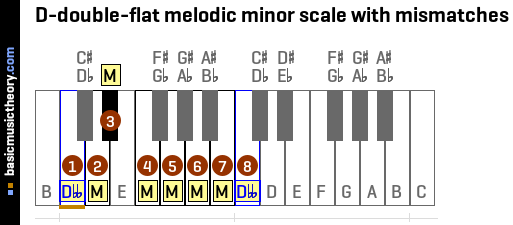
5. Make the D-double-flat note name adjustments
The adjustment explanation below needs to be applied to every mismatch m in the above table. The first mismatch is used as an example.
The match fails when trying to find a E-type of scale note, because either this type of note does not exist in this scale, or it exists but is in the wrong position number / table row for this match.
But music theory rules allow the name of any note to be sharpened or flattened, even white note names, so since a E-type of note name is needed, the real scale note D will be renamed to Ebb.
Of course, even though the note is named Ebb, when it comes to playing the note on an instrument, the real note D is really played.
The adjustments done in this step do not change the pitch / sound of the note, only the name of the note.
After doing the adjustments to all mistmatches, all letters A..G will have been used for this minor scale, and no rules have been broken.
Note that sometimes it is necessary to adjust the note name two half-tones / semitones forward or back, which will result in an adjusted name containing a double-sharp or double-flat.

| No. | 1 | 2 | 3 | 4 | 5 | 6 | 7 | 8 |
|---|---|---|---|---|---|---|---|---|
| Note | Dbb | Ebb | Fbb | Gbb | Abb | Bbb | Cb | Dbb |
6. D-double-flat melodic minor scale reverse descending
The first variation for descending notes is to just reverse the ascending notes and note names as shown below.
This descending note variation is mostly used in non-classical music eg. Jazz, but is occasionally used in classical.

| No. | 1 | 2 | 3 | 4 | 5 | 6 | 7 |
|---|---|---|---|---|---|---|---|
| Note | Cb | Bbb | Abb | Gbb | Fbb | Ebb | Dbb |
| Bass Clef: | Midi | MP3 | Treble Clef: | Midi | MP3 |
7. D-double-flat melodic minor scale classical descending
The second variation for descending notes is to use the descending notes from the Dbb natural minor scale, as shown below.
This descending note variation is often used in classical music.

| No. | 1 | 2 | 3 | 4 | 5 | 6 | 7 |
|---|---|---|---|---|---|---|---|
| Note | Cbb | Bbbb | Abb | Gbb | Fbb | Ebb | Dbb |
| Bass Clef: | Midi | MP3 | Treble Clef: | Midi | MP3 |
8. D-double-flat melodic minor scale degrees
Scale degree names 1,2,3,4,5,6, and 8 below are always the same for all major and minor scales (ie. 1st note is always tonic, 2nd is supertonic etc.) , but obviously the note names will be different for each scale / key combination.
In the melodic minor scale, the 7th note is called the leading note or leading tone because the sound of the 7th note feels like it wants to resolve and finish at the octave note, when all scale notes are played in sequence.
It does this because in this scale, the 7th note is only 1 half-tone / semitone away from the 8th note - the octave note. The Dbb major scale and Dbb harmonic minor scale scales share the same property - they both have only one half-tone / semitone between the 7th and 8th notes.
In contrast, the Dbb natural minor scale has a whole tone (two half-tones / semitones, two notes on the piano keyboard) between the 7th and 8th notes, and the 7th note does not lean towards the 8th note in the same way. In this case, the 7th note is called the subtonic.
| Note no. | Degree name |
|---|---|
| 1 | Dbb is the tonic of the D-double-flat melodic minor scale |
| 2 | Ebb is the supertonic of the D-double-flat melodic minor scale |
| 3 | Fbb is the mediant of the D-double-flat melodic minor scale |
| 4 | Gbb is the subdominant of the D-double-flat melodic minor scale |
| 5 | Abb is the dominant of the D-double-flat melodic minor scale |
| 6 | Bbb is the submediant of the D-double-flat melodic minor scale |
| 7 | Cb is the leading tone of the D-double-flat melodic minor scale |
| 8 | Dbb is the octave of the D-double-flat melodic minor scale |
| Key | C | C# | Db | D | D# | Eb | E | E# | Fb | F | F# | Gb | G | G# | Ab | A | A# | Bb | B | B# | Cb | All On 1 page |
|---|
| Related links | D-double-flat melodic minor scale, Dbb, Dbb melodic minor key signature |
|---|---|
| More minor scales | Dbb natural minor scale, Dbb harmonic minor scale |
| Other scales | Dbb major scale |
| Intervals | Dbb-1st, Dbb-2nd, Dbb-3rd, Dbb-4th, Dbb-5th, Dbb-6th, Dbb-7th, Dbb-8th |
| Circle of 5ths | Learn the circle of fifths |
| Triad chords | Dbb diminished, Dbb minor, Dbb major, Dbb augmented, Dbb suspended 2nd, Dbb suspended 4th |
| 6th chords | Dbb minor 6th, Dbb major 6th |
| 7th chords | Dbb dim 7, Dbb half-dim7, Dbb min 7, Dbb min-maj 7, Dbb dom 7, Dbb maj 7, Dbb aug 7, Dbb aug-maj 7, Dbb maj 7 sus2, Dbb dom 7 sus4, Dbb maj 7 sus4 |
| Cadences | Dbb major perfect authentic, Dbb major imperfect authentic, Dbb major plagal, Dbb major half, Dbb major deceptive |